#(( AKA WHY MIRANDA IS SO CONSTANTLY WEIRD AND PUT-DOWN ALL THE TIME
Explore tagged Tumblr posts
Text

(( Merfolk are hypersocial macropredators. This shouldn't be new information to anyone on my blog, but the sheer extent of merfolk sociability cannot be overstated. Their social nature is the entire reason they were able to become and specialize into macropredatory niches in the way that they have. Their close relatives, the leviathans, are an excellent example of what merfolk might have become if they didn't have their intense communal proclivities — being much more typical, expected examples of a secondarily aquatic large marine predator akin to marine reptiles of the past and whales of the present. Without their social bindings, merfolk might have entirely lost their hands for flippers, would lack their heightened connection to sound and language, and certainly wouldn't have shaped the ecosystems and the world they inhabit in the same way.
For this, merfolk relationships are complicated. They started as a way of forming a simple hunting group and handling life in large colonies, but as merfolk specialized further, so too did their relationships. More and more they focused on interpersonal politics and the complications of maintaining a large social group that was constantly evolving and shifting, which fostered the growth of their intelligence and sapience, which then led back even moreso into needing the ability to maintain and keep up with their relationships.
A merfolk in isolation is not a merfolk at all. While the exactness of this thought varies across their different cultures, it still holds true for all of them. On a literal level, merfolk can and do die of loneliness, their social needs as much of a requirement to them as the need for food or water. If you were to isolate a merfolk, to the point where they could not hear nor see anyone else, then they would endure a brutal one or two weeks, and then die. Every other need can be met, they can be otherwise entirely healthy, but without anyone else around, they cannot live.
On the more metaphorical level, a merfolk cannot exist solely on their own. Most merfolk cultures accept that the individual does not exist, and that there has to be some outside dialogue with other merfolk in order for them to even be alive. The self and identity are inherently plural to them, a multifaceted soul which exists in the bodies and lives of merfolk in a group, and which can't be broken down. Maintaining relationships and fostering them is as essential as feeding yourself, or feeding someone else.
For all of this, merfolk require much higher amounts of social interaction and connection. This is not to say that introverted merfolk do not exist, but they would be introverted by the measure of their fellow merfolk, and not by what humans might judge them to be. Much like how even the most introverted human could not endure the life of a solitary snake or spider, an introverted merfolk could not endure the life of an introverted human. Similarly, even an extroverted human could not compare against an extroverted merfolk.
Likewise, not every social interaction is the same to merfolk, and they maintain different emotional connections with different people, fulfilling a wider assortment of social needs. In fact, it is easiest to think of merfolk social structure as being like one large, interwoven, piece of lace, where each individual merfolk is represented by a single knot. They are all tied together into larger pieces, repeating patterns, all working together to create a singular, complex web of all the ways every merfolk is connected to every other merfolk.
For this, merfolk have different names for each different pattern, each different part at different scales and sizes. All are important, even if some are closer and tied nearer to the individual merfolk in question, and require greater maintenance to keep healthy.
These patterns and connections are, by far, what is most important to a merfolk. While merfolk are fully capable of experiencing platonic, familial, romantic, and sexual connections, it should be stated that this is not what the relationship hierarchy is based off of. They might be a part of that connection, but the connection itself and the place it occupies within the hierarchy is of far greater importance to a merfolk, to the extent that all else pales before it. Any point and connection within this web might be platonic, or familial, or romantic, but even a romantic connection to a merfolk might mean nothing against a platonic or familial connection if the latter outranks the former on their hierarchy of relationships.
Hence, from the smallest unit to the largest, this is (approximately) what the merfolk hierarchy of relationships looks like:
Yuu'itv + Ul’kiha
This can be thought of as the singular knot, as the individual merfolk themselves. This is what is most familiar to landfolk, as it typically does not refer to any more than one merfolk.
To the merfolk themselves, however, this is more theoretical and functional than a real part of their relationship hierarchy to be maintained. This is the building block of identity, the pieces which make up one true self, but pieces which are not as concerning or deserving of as much time as the selfhood itself.
The exception, as you might have noticed, is the inclusion of ul'kiha at this rung. Ul'kiha (in the common-technical language) is loosely translated as the water that runs through someone's gills, but in the plural. Less literally, it refers to a shared breath, a breathing as one. A shared body, in less flowery terms. Soulmates, in the easiest localization.
In short, an ul'kiha is another merfolk and individual who is so close to another merfolk that they are thought of as one person. A plural-becoming-singular, if you might. Other merfolk will treat two ul'kiha as the same person, talk to them as the same person, view their relationships to them as one person. It represents the tightest, closest bond any merfolk can have.
For this, ul'kiha are rare. Most merfolk will never take an ul'kiha in their lives, and for those that do, taking more than one is next to unheard of. Ul'kiha is, likewise, the only instance where a rung in the relationship hierarchy is solely romantic, and the only true crossover between the relationship hierarchy and humanity's views on relationships. While half of ul'kiha will refuse to take any other romantic partner, this is not comparable to marriage either, as the intensity of this connection could be thought of as codependent in a way that's natural for merfolk but doesn't occur in human relationships. While ul'kiha can split up, if one ul'kiha dies and the other doesn't, the living partner is expected to never take another ul'kiha again, and quite often the loss is enough to kill them too.
Miivt'ia
These are the first few knots the initial knot is tied to, and the first true rung on the relationship hierarchy.
In a sense, the miivt'ia is a merfolk's inner circle. These are the people who they are closest to in their lives, who they have a unique and potent bond with. A miivt'ia, likewise, is a group which is exclusive to itself, and all the members of a miivt'ia will feel the same way about each other, and count themselves in each other's miivt'ia.
The closest example we might have to what a miivt'ia is would be the concept of a friend polycule. None of the members inside a miivt'ia are exclusively platonic, familial, romantic, nor sexual with each other, but they have a tight and exclusive bond which is solely shared amongst each other. In fact, each member of the miivt'ia might feel differently about every other member of the miivt'ia and have their own, unique dynamic with every other member, but all are united in the closeness given by being members of the miivt'ia.
Miivt'ia are often formed right as a merfolk is first growing up. Family members can be included in the miivt'ia, but not always, and those included are almost always siblings, cousins, or others who are similarly close in age. Childhood friendships that begin to deepen often become a part of the miivt'ia, as are the most serious of relationships. However, miivt'ia can also be created outside of these formative years, and there are many miivt'ia that essentially act like guilds or a "family" business, being closer than mere coworkers but sharing the same job.
Miivt'ia are the people with whom a merfolk has near-constant contact with. They are expected to live together, and often will share the same job, or similar jobs. All of their personal belongings are considered as belonging to the miivt'ia over any individual, and legally the miivt'ia is the individual upon which laws apply to. A merfolk without a miivt'ia is effectively homeless, and spiritually merfolk consider the miivt'ia to be the soul. Merfolk that go through the Coral Festival (Habp'll pl'qe ane'jhe Oikahj) will go through it together with their miivt'ia. Any children the miivt'ia has or adopts is considered the child of everyone else in the miivt'ia, the members all acting as parents and considering themselves equally as responsible in the care for that child. Miivt'ia are not only expected to be constantly in contact with each other and to participate in everything together, but they are expected to care equally about every other member of the miivt'ia and to feel each other's emotions as one.
For all of this, merfolk are highly loyal to their miivt'ia and will defend the members of their miivt'ia with their life. Any threat to any other member of the miivt'ia is considered a direct threat to all other members and to the individual merfolk's lives, and the loss of any member of the miivt'ia is mourned by all others to the highest degree.
There is a lot of responsibility placed upon those included in the miivt'ia, but the miivt'ia also has an emotional closeness and intimacy that isn't shared by any other merfolk in the relationship hierarchy (except the ul'kiha, see above). Being too overtly close and intimate with a merfolk can be seen as not respecting the miivt'ia and be seen as a threat to the security of the miivt'ia. Likewise, if someone wishes to join a miivt'ia, they will often endure a "courting" phase with all the members of the miivt'ia, where they attempt to forge connections equally as close to and intimate with every other member.
Dhe'jny'p usae
If the miivt'ia was the smallest initial pattern any relationship can have in the larger weave, then the dhe'jny'p usae is the actual shape of that pattern, when something becomes not just an oval, but a petal on a flower.
Dhe'jny'p usae, in common-technical language, is closest translated to "drift family". Humans might recognize the dhe'jny'p usae as being something similar to friends. They are not as close as the miivt'ia, but they might represent the next nearest thing, being a close emotional connection with associated responsibilities. The dhe'jny'p usae would be the closest other miivt'ia to the existing miivt'ia, acting as neighbors or close-knit family. If the miivt'ia had children, then they would be expected to provide care and look after those children alongside their own, and would cycle wider, communal responsibilities with the miivt'ia. Miivt'ia and members of the miivt'ia would hang out with and spend a lot of time with their dhe'jny'p usae, and this forms the base of wider merfolk sociability.
While the dhe'jny'p usae would be excluded from the private, domestic matters of the miivt'ia, they might still be gone to for emotional reassurance, or to simply have someone to talk to. Dhe'jny'p usae are expected to help in providing food for each other, and will switch out communal duties that require a layer of intimacy with each other, and legally are considered very similar entities. While they wouldn't share all personal belongings like the miivt'ia, they might share what counts for money, and be responsible for dividing it up among themselves. Dhe'jny'p usae, likewise, might live together in larger communal houses and share chores among themselves, but this might be considered closer to the individual members of a household, and its not as intensely expected for them to live together as the miivt'ia.
Dhe'jny'p usae are likewise the most common place to find what we might think of as typical merfolk romantic relationships. Dhe'jny'p usae more easily come and go, leaving and entering a merfolk's life, not solely remaining there for life like the miivt'ia, and for that, it's not uncommon for merfolk to have romantic and sexual relationships with their dhe'jny'p usae.
Faa'nek hus'llu
If the dhe'jny'p usae were the equivalent to people living in the same house, the faa'nek hus'llu is closer to the neighbors. These are acquaintances, support-friends, those that they are close to, though they maintain a degree of separation. If the dhe'jny'p usae was a flower, then this is the daisy chain, the interlocking patterns which form a distinct function.
More than anything else, the faa'nek hus'llu can be thought of as the connective tissue. They bridge the gap between the intensely bound and closely connected dhe'jny'p usae and miivt'ia, and the wider social community of merfolk. They do not bear the brunt of the emotional responsibility and are free to come and go in any merfolk's life as they please, but there is still a degree of familiarity here, a sense of belonging. While dhe'jny'p usae might live in the same communal house, faa'nek hus'llu live in the same town, neighborhood, community. The responsibilities they bear are far more physical, often serving as shifting turns for communal guard or repair duties, ensuring that everyone gets their turn taking care of everyone else.
The downside is that faa'nek hus'llu enjoy far less emotional connection and intimacy. What is shared and offered is far more obvious and physical, and far less detailed than that which other, closer relationships would receive. They might know someone is tired, and they might know someone is in grief after losing a member of their miivt'ia, but they wouldn't be able to navigate the emotional complexity beneath that. Trying to do so can be seen as a threat, either to your own dhe'jny'p usae and miivt'ia, or to theirs, demanding familiarity which has not been earned nor received.
A'antiu Muur'l
This is the far end of any merfolk's immediate social connections. The a'antiu muur'l is not merely the knot, nor the petal, nor the flower, nor the daisy chain, but the sides of the lace itself, the largest part that fits together with all others.
This is the community as a whole. It is a town, a city, a city-block, more of a legal entity than a social one but a social one nonetheless. The a'antiu muur'l is far more location-based than the other rungs on the relationship hierarchy, and merfolk only truly change their a'antiu muur'l with a change of physical location. The a'antiu muur'l is the community from which community names are given, and the a'antiu muur'l is to the commonfolk what a royal lineage is to a royal.
The a'antiu muur'l in common-technical best translates to "song family", and to a merfolk, this is because it is intended to include everyone that a single merfolk might hear at any given time. They are strangers to the individual merfolk, sure, but they are all singing together and speaking at the same time, and working to build the same song together to flesh out life and the place in which they live, so there is a degree of emotional connection. It is abstracted emotional connection, yes, but it is emotional connection all the same.
Merfolk might even include physical landmarks as part of their a'antiu muur'l, such as in the case of their singing buildings, or for a particularly endearing local landmark. This can include a large reef, or mountain, or entire mountain range, but so too can it include the one weird shady area where all the kids hang out that the adults don't want them near.
Ghray Uw'ghta Faahl
In common-technical language, the ghray uw'ghta faahl means "all-body". It is far more theoretical than the others, being spoken of to promote a sense of universal connection, but is not something that's quite so easily envisioned in turn.
In essence, the ghray uw'ghta faahl refers to all merfolk. All of their connections, each a'antiu muur'l, each faa'nek hus'llu, each dhe'jny'p usae, each miivt'ia, and each yuu'itv. Each and every merfolk is included, down through time, because each and every merfolk has had an emotional connection, and thus each and every merfolk fits into the ghray uw'ghta faahl.
Thus, the responsibilities here are far more abstracted, and far more represent the responsibilities all merfolk have to each other. This includes their hospitality culture, yes, but far moreso it includes a sense a dignity and a need to recognize that each merfolk has someone else and belongs somewhere within the ghray uw'ghta faahl. It's a source of recognition, and of community, and of understanding.
How much it actually fulfills that role, as ever, varies, but the thought and theory and gesture is still there, all the same.
#Most secret royal advisor || OOC#Given by Divine Right || Headcanons#And no matter what you choose‚ you're gonna live it || Wishlist#(( i am going to reread over this later and edit it then but#(( i am posting this NOW it is DONE i dont want to LOOK AT IT ANYMORE#(( BEHOLD. THE MERFOLK RELATIONSHIP HIERARCHY.#(( AKA WHY MIRANDA IS SO CONSTANTLY WEIRD AND PUT-DOWN ALL THE TIME#(( AND ENDURES UNREQUITED FEELINGS FOR HER FRIENDS THAT ARENT ROMANTIC NOR PLATONIC BUT SOME SECRET THIRD THING#(( do you realize the hell shes been going through. do you See.#(( and yes if you ask me i know exactly where each and every muse is on this hierarchy for miranda#(( yes this does have consequences and is part of why she acts the way that she does
13 notes
·
View notes
Text
10 Reasons Why Carrie Bradshaw Wasn’t THAT Bad...
Sex and the City is the most elite series I’ve ever watched - and I was so excited to purchase the first season when I turned 18.
I would listen to my mom and my sister gossip about the show when I was younger and feel so left out. But, my mom would refuse to let me watch it until I became an adult. Thank god.
Being an avid fan now, I sometimes scan through Sex and the City articles on the net, and can’t help but notice dozens of articles filled with ‘Carrie’ slander - which kind of makes me nervous.

Although it was true that years ago girls were labeling themselves as the ‘Carrie’, ‘Samantha’ and ‘Charlotte’ of the group - the serious and less glamorous friend got stuck with being a ‘Miranda’; it is kind of an insult now to be deemed as a Carrie.
As we all matured, we realized that being a Miranda is amazing and we should all strive to be just as successful - but Carrie Bradshaw is still a valid character and I’m here to prove why the “sexual anthropologist” is not all that bad.
Now before I dive into why I totally get Carrie Bradshaw, I would just like to point out before hand that I am aware that she is just a fictional character and hopefully you are too. If you are not informed, then I apologize for this harsh revelation. However, let’s continue.
1. She was average looking
While we can all agree that her physique only gets stronger and leaner throughout the series, she was still not exactly perfect looking. Despite her fit body, she was not model like or necessarily tall. She did not have a perfect nose. She did not have the biggest ‘lady parts’. She did not have the plumiest lips. She did not have perfect facial symmetry.
But, she was okay with it. And has mentioned that by the age of 30, she was over being uncomfortable with her looks and decided to move on.

Despite constantly bumping into models and having to accept that men can be total “modelizers” - especially in the capital of the world aka manhattan, she chose to embrace her natural beauty, which in turn has allowed her to walk the runway in her underwear.

2. She was selfish
Yes, the new trend is to be selfish and say no - because that is ‘self love’.
If that truly is the case, then there was no denying then that Carrie was selfish throughout the series.
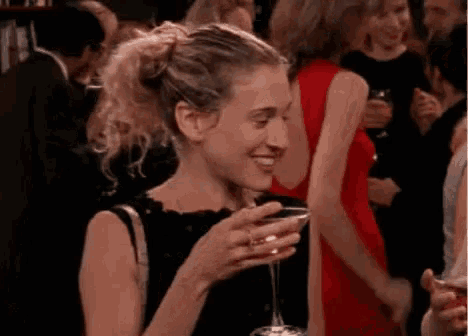
As human beings, we are selfish by nature. But since we now identify ourselves in societies with expected norms and values, being selfish disqualifies you sometimes from your environment. To avoid being lonely, we try to let go of being selfish or at least hide our selfish traits.
Unfruitfully so, our selfish instincts at times fail us - exposing our true colors. And whenever that happens, people aren’t too afraid of pointing out what you did wrong. It doesn’t make us necessarily evil, just makes us human.
To avoid being Freudian in this post, let’s just sum up that Carrie is harmlessly selfish at times - that includes being late to every event, asking her friend Susan Sharon if she could trade in her cashmere sweater birthday gift for cash, accepting a pair of 600$ shoes from her other super rich friend, and cutting off Charlotte’s possible infertility problem discussion to talk about her Manolos.

The list goes on, I mean - this is just classic Bradshaw behavior. However, this character cannot be deemed as bad. She was just under the spotlight, and if we were under it too, we would find out that we do have these moments as well without realizing it. We are not perfect. However, Carrie does reflect on her mistakes often, which is something we should be doing more.
Sometimes, her selfish tendencies can really get out of hand.
It was not okay when she got angry at Charlotte who did not offer to lend her money after she blew it all off on Manolo Blahnik shoes instead of rent. It was not okay when she threw away Aiden down the drain. It was not okay when she slept with a married man, even if it was ‘Mr. Big’.
We cannot shame her though because we all have hidden skeletons in our closets...it’s up to you however to peak in and see which faults make it or break it for you.
3. She was a working woman
No offense to chastity ball princess Charlotte, who wanted to be a housewife to any rich man who crossed path with her, Carrie Bradshaw was by all means an ‘all star’ business woman. Despite being unconventional unlike Samantha Jones (PR executive) and Miranda Hobbes (Harvard-graduate Lawyer), Carrie Bradshaw was a restless woman that worked in multiple fields all at once despite being so undermined.

She had so many tasks to tackle all at once while juggling multiple projects. She ran around between the fields of Journalism, Content Marketing and Public Relations. She was able to get invited into all the ‘fabulous’ events and meetings because of the hard work she invested in all by herself as a freelancer who lived in a huge place like New York. Carrie finally reached her goal at the age of 40, which was working at Vogue. She even wrote multiple books as well.

4. She was unconventional
Despite the show running in the early 90s, Carrie Bradshaw decided to be a sex columnist. She never gave up on her weird unconventional job and was proud of her career despite the looks or comments people would make. She had a weird exterior in addition to how upfront she was about the physical makings of life.

In addition, Carrie did not believe in marriage until she became a fiancée at the age of 40. She traded in a ring for a pair of shoes and a walk-in closet, unlike most women, who would rather get married in their mid 20 to early 30s with a huge rock on their finger.
5. She was struggling at adulting
Carrie Bradshaw had a deluded concept of adulting that at least most of us had or still struggle with. She was not a healthy adult with financial stability and a well thought out regime. However, she still managed to be fabulous.

She had poor dieting habits, which made her sometimes skip dinner to buy Vogue instead. She believed that shopping and gossiping were the best types of cardio. She was not the cleanest and had a messy apartment at most times. She did not care about the way her living space looked like, which she later on freaked out about in fear of being judged as an imperfect adult according to Mr Big. She paid so much on shoes that she could no longer afford her rent. She believed that investments must be seen in her closet. She drank at least six dollars worth of coffee per day. She would smoke and drink way too much for a thirty year old woman.
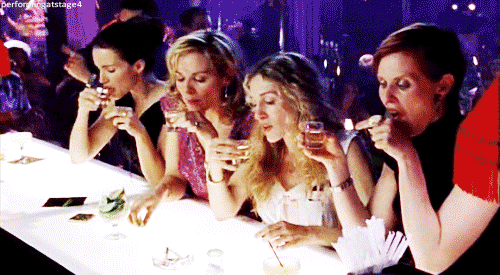
6. She was a good friend
Carrie Bradshaw had so many friends that it almost put her PR bestie Samantha to shame. To be honest, Carrie may have not been a perfect friend, but she was as good as it gets realistically.
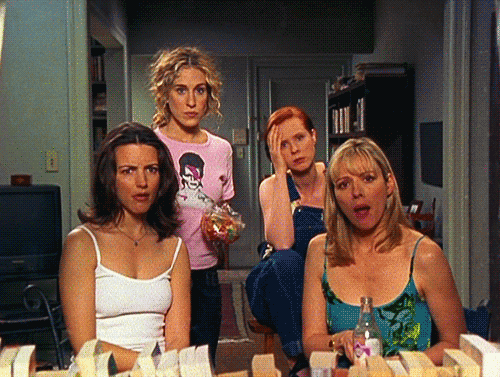
What made her so realistic in her friendships was her ability to be there for most of her friends’ hardships. She had her ups and downs with her empowered female group because sometimes they would feel like she was too problematic and vice versa. For the most part, it is impossible to be as passionate to your friends as you once were the first time you guys met. But what makes a friend a good one is that they never voluntarily try to find excuses to leave you behind.
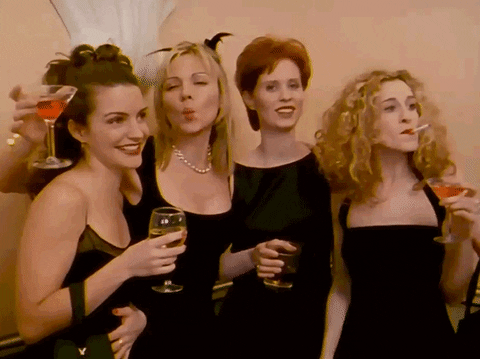
Carrie’s love towards her friends in her good and bad times showed that she valued them like family.
7. She was lost
Carrie was probably more lost than she would have liked to be. She had a tendency to dwell on what should have been and could have been. We all have regrets and sometimes she voiced hers out more than other characters within the show. She would sometimes yearn over the years that passed by her. She even went to extremes such as dating a college boy just to remember what it was like to ‘just kiss’. Rookie Mistake, Carrie.

Just like Carrie, as time goes by at any age, we look back at the spur of events that created our timeline and take note sometimes of which events we deem as either life-changing, traumatizing or both.

8. She was experimental
She may not have been as promiscuous as her friend Samantha, but she was unarguably adventurous in all aspects of her life. Although the most obvious aspect may have been her outfits, her wild colors and funny textural accessories were just a preview on how eccentric Carrie Bradshaw truly was. She mentioned that her younger years were a genuine pursuit of fun in every shape or form, which most twenty-something-year-olds cannot deny.

She emphasized that she fears living life as a cautious person because of the hurt she has endured. However, she truly defined throughout the show what it means to be eccentric, empowering the ones who fail the experiments of life to get back on their feet.
9. She was flawed
Carrie Bradshaw believed in the glass half full rather than half empty throughout the series. Despite being unbearably flawed to the point where her friends no longer wanted to listen to her problems, she decided to see a shrink which is something that would have been especially socially-unacceptable in the 90s. Carrie still overcame her mental issues and found other remedies which in turn has led her into accepting the way things played out.

As we grow up, we, like Carrie, need a little bit of help in order to realize that temporary issues will fade away into lessons and the permanent ones that are out of our control can be accessorized into our lives accordingly to the way that we want it to look like.
10. She was in love
Her love towards Mr Big was illogical - almost completely insane. But what made her character so special was the fact that she never continued her relationship with Aiden because she knew deep down that it was Mr Big all along and never gave up on it; despite all the signs that kept telling her that he was bad for her. He was at the time indeed bad news, which made her feelings towards him fluctuate between love and hate.
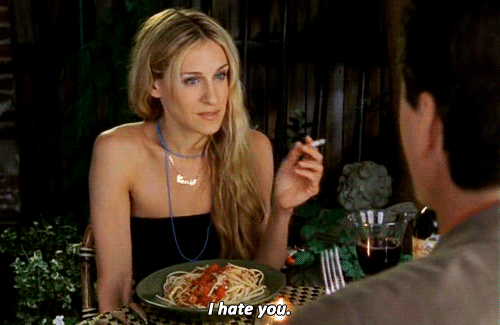
Now, the psychology behind her and Mr Big does not justify why you should call your ex right now so put your phone down, but it is something to think about.

Carrie took the road not taken for most women, especially during the 90s where gender roles in love where still a bit rigid. While it is true that it is always easier to date lovers who make the effort to chase you rather than pursuing it yourself, the easiness does not create the ‘fairytale love’ that most of us strive for.
Carrie once described her love towards him as a crash rather than a crush. But if something deep down is telling you that someone is your person, shouldn’t that account for something? Shouldn’t we all just go for ‘ ridiculous, inconvenient, time-consuming can’t-live-without-each-other love’, and get it right just like she did?
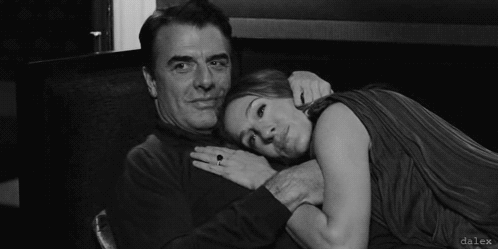
- Nina xx (yasminasayyid)
#carrie bradshaw#Sarah jessica Parker#satc#sex and the city#sex and the city 2#Samantha jones#Miranda hobbes#quotes#mr big#Charlotte york#chris north#Cynthia Nixon#kim cattrall#kristin davis#new york#Manhattan#new york city#vogue#cosmopolitan#beauty#buzzfeed#betches#media#psychology#content marketing
58 notes
·
View notes